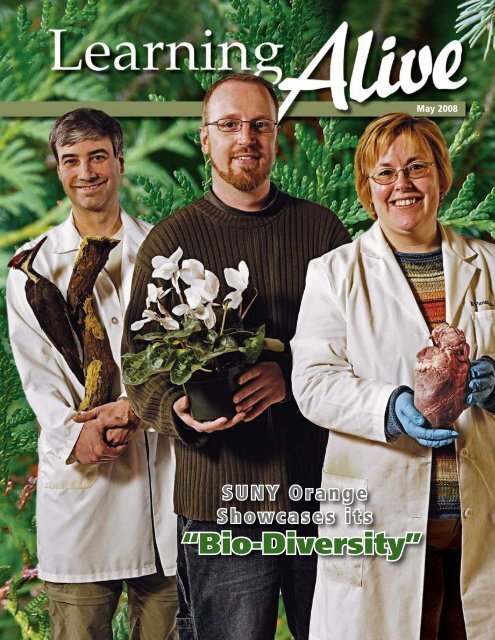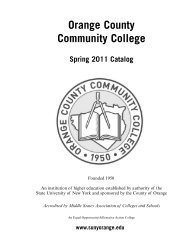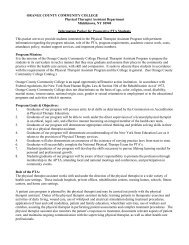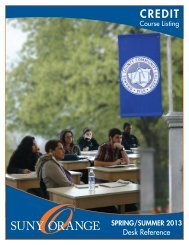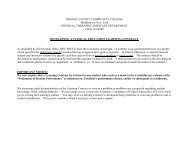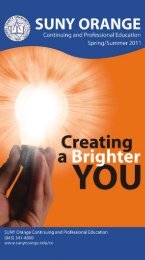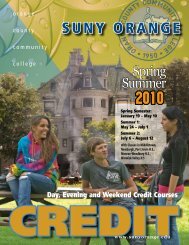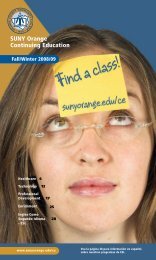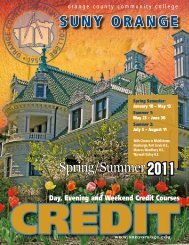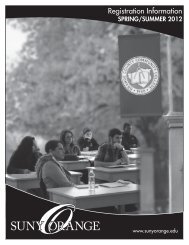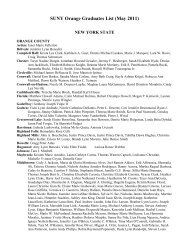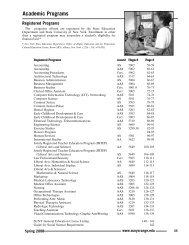Entire Magazine - SUNY Orange
Entire Magazine - SUNY Orange
Entire Magazine - SUNY Orange
- No tags were found...
Create successful ePaper yourself
Turn your PDF publications into a flip-book with our unique Google optimized e-Paper software.
S U N Y O r a n g eShowcases its“Bio-Diversity”May 2008
Learning A liveThe Academic Affairs<strong>Magazine</strong> of <strong>SUNY</strong> <strong>Orange</strong>Dr. Catherine ChewVice President for Academic AffairsMike AlbrightEditorNihal MahawadugePhotographyDon HamermanSupplemental PhotographyCreative Graphics by Marc TolenGraphic DesignOn the CoverFrom left, Dr. Joe Zurovchak(ornithology), Monty Vacura (botany)and Dr. Shelly Paradies (neuroscience)demonstrate the breadth of diversitythat members of the College’s BiologyDepartment bring to the classroom.WelcomeTeamwork is a critical element in the success of any organization, business or college.To prosper as a group, individuals must be able to work in harmony with others, bothinternally and externally.I’m proud to say that the staff and faculty at <strong>SUNY</strong> <strong>Orange</strong> excel in their ability tocollaborate with one another, unite their resources and strive toward a common goal. Theyalso have demonstrated a willingness to embrace innovative ideas from outside the Collegewhile creatively teaming with business and civic leaders, and community members, toenhance our students’ educational opportunities.In this edition of Learning Alive, you’ll read about our outstanding Biology Department,under the direction of Dr. Frank Traeger. This talented and creative group of educators andadministrators is at the forefront of several exciting new initiatives on campus.You will also learn about how our Continuing and Professional Education staff isexpanding the College’s outreach in business training, professional development programsand non-credit education. You’ll see that a group of faculty sought to develop several“humanities initiatives” that sharpened their focus on classroom teaching, and you’lldiscover how a wide cross-section of campus personnel developed a model “learningcommunity” aimed at assuring a positive “first year experience” for selected students.We have young, energetic faculty who are bringing new ideas and backgrounds to theCollege, and seasoned professors who are enhancing their expertise with contemporaryteaching methods. In the end, their wonderful efforts are keeping learning “alive” at<strong>SUNY</strong> <strong>Orange</strong>. Vice President for AcademicSincerely,Dr. William RichardsPresident, <strong>SUNY</strong> <strong>Orange</strong>115 South StreetMiddletown, New York 10940845-344-6222www.sunyorange.eduDr. William RichardsPresident<strong>Orange</strong> County Community Collegeis an equal opportunity/affirmativeaction institution. In accordance withFederal regulations, the New York StateHuman Rights Law and Section 504 of theRehabilitation Act of 1973, <strong>Orange</strong> CountyCommunity College does not discriminateon the basis of age, color, religion, creed,disability, marital status, veteran status,national origin, race, gender or sexualorientation in employment or in theeducational programs and activitieswhich it operates.Learning Alive welcomes your ideasfor future articles. Topics shouldfocus on academic initiatives and thestudents, faculty and staff who aremaking learning come alive.E-mail the editor atmike.albright@sunyorange.eduHuman beings need community, that sense of belonging and contributing to somethinglarger than oneself. Community Colleges adopted the term as their unique descriptorduring the 1960’s and 1970’s—their era of greatest expansion. The term “community” at<strong>SUNY</strong> <strong>Orange</strong> includes activities in the classroom; in the department, within the College asa whole, or in relation to local, national and international society.In an academic year in which we faced a variety of stressors that affected our dailyroutines, it seems important to be reminded that community building and teamwork areever present and bountiful at <strong>SUNY</strong> <strong>Orange</strong>. Within the pages of this third issue of LearningAlive are stories about people and departments who individually and collectively aremaking significant contributions to the College community, and beyond.For example, read about the First-Year Experience “movers and shakers,” a team thatis connecting the curriculum and helping students bond through a unique learningexperience. Or read about the Biology Department, an “awesome” team of extremelytalented and gifted faculty involved in anything and everything from environmentalsustainability and ecological conservation to technological innovation and campusbeautification.Learning Alive is intended to showcase colleagues in Academic Affairs and this issuesurely hits the mark. As you peruse the pages, I am certain you will be impressed byour activist community—a community that shares a common interest in learning andprofessional involvement. When we collaborate, work as a team and move beyondindividual perspectives into the realm of common understanding, the possibilities arelimitless. Enjoy your read!Sincerely,Dr. Catherine ChewVice President for Academic Affairs2 Learning Alive The Academic Affairs <strong>Magazine</strong> of <strong>SUNY</strong> <strong>Orange</strong>
AliveLearningStrong internal teamwork and creative alliances with thoseoutside of the College help keep learning “alive” at <strong>SUNY</strong> <strong>Orange</strong>.4 In the NewsTeaching and learning come alive at <strong>SUNY</strong> <strong>Orange</strong> thanks, in part, to teaching excellence,academic partnerships, technological support, community outreach and international relations.81822127 The Latest Chapter.The new faculty members who comprise <strong>SUNY</strong> <strong>Orange</strong>’s “Class of 2007” arrived at the Collegewith varied backgrounds and unique perspectives on education.8 Creating a Positive “First-Year Experience”Modeled after a program operated successfully by Kingsboro Community College, staff andfaculty at <strong>SUNY</strong> <strong>Orange</strong> crossed course and professional boundaries to create a pilot “First-YearExperience/Learning Communities” program.11 A Renewed Focus on Teaching and the ClassroomA group of <strong>SUNY</strong> <strong>Orange</strong> faculty within the Liberal Arts Division blended a creative mixof ideas, culled from discussions held throughout the 2007-08 academic year, into several“Humanities Initiatives” that will benefit students.18 Teamwork Fuels CAPE SuccessThanks to a strong team of administrators, the College’s Continuing and Professional EducationDepartment has successfully retooled and integrated its programming, operations, sales andmarketing strategies to create a recipe for success.22 Bringing International Education to <strong>SUNY</strong> <strong>Orange</strong>A gleaming new Gilman Center for InternationalEducation, revised academic offerings and aninflux of new faculty will allow <strong>SUNY</strong> <strong>Orange</strong>to globalize its curriculum and offer students afirst-rate academic pathway to the internationalcareer of their choice.Cover Story:Demonstrating its “Bio-Diversity”With a full-time faculty roster numbering 10 strong thatis aided by a network of reliable support personnel, <strong>SUNY</strong><strong>Orange</strong>’s Biology Department is among the College’s largestand most diverse. The faculty members boast an impressiveportfolio of specialties, including family medicine, anatomy andphysiology, neuroscience, ornithology, ecology, environmentalscience, dendrochronology, botany, evolutionary biology,genetics, developmental biology, nutrition and herpetology.Under the direction of Dr. Frank Traeger, the departmentaspires to a mission that is equal parts service, academics,campus enrichment and innovation.May 2008<strong>SUNY</strong> <strong>Orange</strong> 3
IN THE NEWSTeaching Excellence RewardedProfessors Dr. Karen Stephens and Steve Winter, who havecombined for nearly six decades of exemplary service to <strong>SUNY</strong><strong>Orange</strong>, were named as winners of the President’s Award forExcellence in Teaching during the Spring 2008 semester.Winter, the longest tenured faculty member currently at the Collegein a full-time role, has been teaching business-related courses herefor more than 40 years. Stephens, who attended <strong>SUNY</strong> <strong>Orange</strong>as a student, has held a faculty position in the Physical TherapistAssistant Department since 1992.“At the heart of our work is ‘teaching and learning,’ and Karen and Steve exemplify thebest of what we do,” says Dr. Catherine Chew, vice president for Academic Affairs.Throughout his tenure at the College, Winter has been a leader and visionary inimplementing new and innovative programs designed with student learning in mind.Nearly 30 years ago, he was the first <strong>SUNY</strong> <strong>Orange</strong> professor to offer an Honors Course. Heinstituted the use of advisory boards in the Business Department that continue to supportthe College today.More recently, he has actively pursued the use of instructional technology, havingdeveloped an online course for Principles of Marketing while also offering web-enhancedmaterials to supplement each of the courses he oversees today.Winter’s innovative ideas stem for a teaching philosophy in whichhe is committed to creating a partnership in the classroom. Heunderstands and nurtures an informative and respectful rapport withstudents.On developing that classroom atmosphere, Winter remarks, “It isalways a work in progress. All parties must be flexible and seek theproper balance so we create an optimum fit to achieve learning.”A revered colleague and professor, Stephens has consistentlydemonstrated a strong respect for the welfare, value and dignityof her students, who gravitate to her easy instructional style andbenefit from her guidance. She is a strong student advocate and isconsistently called upon by the Student Services staff to assist withstudent advising.Steve WinterDr. Karen StephensIn addition to the vast clinical background she brings to theclassroom, Stephens has been a strong proponent of developing supportive and effectivelearning environments—implementing instructional methods that feature small studentdiscussion groups and embedding critical thinking throughout her curriculum.“I try to provide a stimulating learning environment that allows the student to feel free toask questions and respond to questions without fear of censor,” she explains.As winners of the President’s Award, both Stephens and Winter have been nominated forthe 2008 State University of New York “Chancellor’s Award for Teaching Excellence.”Bridging theAcademic GapIn 2008, <strong>SUNY</strong> <strong>Orange</strong>’sCollaborative Faculty Partnershipprogram will once again uniteeducators from the high school andcollegiate ranks to explore howthey may more closely align theacademic expectations placed uponstudents at both levels and increasestudents’ academic success.Building off a productivedebut in 2007, <strong>SUNY</strong> <strong>Orange</strong> isembarking upon the second yearof its faculty partnership programwith <strong>Orange</strong>-Ulster BOCESInstructional Council. In theensuing months, the College willpair its registered faculty memberswith educators from six <strong>Orange</strong>County high schools, as well as<strong>Orange</strong>-Ulster BOCES.“Our goals are to identifyshared expectations forstudents’ success, increasestudents’ academic performanceand promote collaborativeefforts among secondary andpostsecondary educators,” saysRosana Reyes-Rosello,director of <strong>SUNY</strong> <strong>Orange</strong>’s Officeof Educational Partnerships.Participants will be paired(one College faculty memberwith one high school teacher)by teaching disciplines. Theywill work to identify a projector a unit of study with levelspecificrubrics and meaningfulassessment tools. Once their planhas been presented to the entiregroup and refined, the pairs willimplement their initiatives fromSeptember through November.Assessment results will bepresented to College and BOCESrepresentatives in December.4 Learning Alive The Academic Affairs <strong>Magazine</strong> of <strong>SUNY</strong> <strong>Orange</strong>
Halpern Citedfor NursingExcellenceCited as one of theregion’s 50 leadingnursing professionals,<strong>SUNY</strong> <strong>Orange</strong> professorJean Halpern wasselected to receive an “Excellencein Nursing” award as presented byHudson Valley <strong>Magazine</strong>.Halpern and her fellow recipientswere honored during a May eventat the Villa Borghese restaurant inWappingers Falls, N.Y., where theyreceived certificates of recognitionand commemorative gifts. Twentywinners, chosen by a committee ofmedical professionals and editors,were to be profiled in a futureissue of the magazine.The winners came from localhospitals, private practices,schools, nursing homes and otherhealthcare facilities.Jean Halpern“I am extremely honored to havebeen thought worthy of such anaward,” Halpern says. “I only hopethat I have influenced studentsto be the best nurses they can be.Nursing has been my entire lifeand I am so proud to have chosenthis profession.”The awardrecognizes Halpern’stremendousaccomplishmentsthroughout hercareer at the College,but particularly hertireless efforts over the past 18months in bringing “simulationtechnology” to the College’snursing curriculum.“Life-like” simulationmannekins allow educatorsto use current technology inimplementing training scenariosthat cover virtually everypotential medical situation,providing students with “reallife” experiences before theyacquire proficiency in theclinical setting.“Jean is hard-working,enthusiastic and tenacious. Shewon’t stop until she completes aproject,” explains Dr. CatherineChew, vice president forAcademic Affairs. “She is mostdeserving of this award and hasbeen a true ambassador for boththe nursing profession and theCollege.”Students ProvideTax Preparation AssistanceThis past spring, five <strong>SUNY</strong> <strong>Orange</strong> accounting students,along with two students from the Pine Bush Academy ofFinance, earned valuable “real world” experience through theirparticipation in the Volunteer Income Tax Assistance (VITA)program.Upon completion of a thorough training program thatincluded online and classroom work, as well as certification bya representative of the Internal Revenue Service, the studentswere approved to prepare taxes. Daryl Goldberg, accountingprofessor, coordinated the program on behalf of the College.The students were assigned to <strong>Orange</strong> Works, a workforcedevelopment system in <strong>Orange</strong> County that provides links toresources and services in a professional business environmentto individuals who are seeking employment, and to businessesbuilding their workforce. In addition to providing a valuableresource for clients of <strong>Orange</strong> Works, the students’ experiencecertainly adds an important professional element to theirresumes.“We find that our students thrive in situations like this,whether it is participating in the VITA program or completingan internship. They embrace the experience because they knowit will benefit them after they’ve graduated,” says SuzanneKrissler, chair of the Accounting and Office TechnologiesDepartment.Information Commons BringsTechnology to StudentsThe newly created “Information Commons” in the <strong>SUNY</strong><strong>Orange</strong> Library has quickly become the technological epicenterof the Middletown campus by giving students access to nearly60 computer workstations replete with software programs andinternet access.By replacing old book stacks, traditional study stations, cardcatalogs and bound copies of periodicals with contemporaryinformation “hubs,” <strong>SUNY</strong> <strong>Orange</strong> is bringing today’stechnology to the students’ fingertips, says Susan Parry,library director.The College has added a teacher’s station and large-screenmonitor in the existing computer lab to allow Library staffor faculty members to conduct instructional workshops forstudents.“It was imperative that we change from our traditionallibrary approach to a more contemporary space that reflectedthe needs of today’s students,” Parry explains. “We’ve tried tobring available research tools and processes together with thestudents’ productivity needs, and that has been a very positivechange for our students.”May 2008<strong>SUNY</strong> <strong>Orange</strong> 5
Administrators from Oaklands College in the UK visited <strong>SUNY</strong> <strong>Orange</strong> for three daysin early November 2007 to continue discussions that had been ongoing between thetwo institutions for more than a year. Oaklands is part of “Further Education” in Britain,which is trying to implement changes so that country can operate educational programsmore like those at American community colleges. Above, Mindy Ross (second from right),associate vice president representing the Newburgh Extension Center, discusses theCollege’s planned branch campus, which will be situated at the intersection of GrandStreet and Broadway, during the group’s tour of Newburgh. Professor Diane Bliss (left)escorted the Oaklands group in Newburgh.Global InitiativeSucceeds in DebutFrom Dr. Patricio Navia’sopening lecture in April 2007 toa grand Cinco de Mayo event inSpring 2008, <strong>SUNY</strong> <strong>Orange</strong> spentmore than a year concentratingon a myriad of Latin Americancultural, political, social, historicand economic issues duringthe College’s debut “GlobalInitiative.”Helping Children Get SMART This SummerThe <strong>SUNY</strong> <strong>Orange</strong> SMART Program, to beoffered this summer, is yet another exampleof a collaborative effort between academicand administrative departments that yieldsbenefits for the community.Coordinated jointly by the College’sOffice of Educational Partnerships and theOccupational Therapy Assistant Department,the SMART Program—“Sensory-MotorActivities and Recreational Transition”—wascreated for children from pre-kindergartenage through sixth grade.Its goal is to enhance children’s physicaland academic abilities by strengthening andrefining their gross and fine motor skills,sensory-motor integration, handwritingskills, socializing skills and self-esteem.In addition to the children receivingtherapy, all eight sessions will include aquestion-and-answer period where parentscan meet with the practitioners to discusstechniques and resources related to the goalsof each session. The child will also receiveindividualized goals and instruction thatprovides a bridge to the next school year.The Office of Educational Partnerships,directed by Rosana Reyes-Rosello, providesthe administrative oversight and organizationof the program while OTA Department chairFlo Hannes and her staff are coordinating thelineup of licensed and certified occupationaltherapists to support the four-week program.“The program is designed to enhance achild’s skills and to improve their awarenessof self-regulation while enjoying variousactivities. Typical sessions will includesensory-motor warm-ups, visual motor andperceptual activities, with an emphasis on finemotor skills and handwriting,” Hannes adds.“The children will work in small groupsand receive individualized attention, all ina safe, interactive and fun environment,”Reyes-Rosello adds. “This is an exciting andinnovative summer program for studentswith OT needs. Sharing our resources tomeet a local need is an example of ourfulfillment of <strong>SUNY</strong> <strong>Orange</strong>’s mission to bethe community’s college.”A rousing success by allaccounts, the Global Initiativedemonstrated the truecollaborative atmosphere thatexists at <strong>SUNY</strong> <strong>Orange</strong>, drawingparticipation from all cornersof campus.“I couldn’t be happier withthe participation, enthusiasmand collaboration I witnessedthroughout this project,” saysDr. Catherine Chew, vicepresident for Academic Affairs.“Our faculty embraced the GlobalInitiative and our staff supportedit from the outset. And in theend, our students truly reapedthe rewards of the hard work putforth by so many folks on campus.“This project brought a globaloutlook to our curriculum and ourcommunity, and we will certainlybe able to build off its successin future Global Initiatives,”Chew adds.6 Learning Alive The Academic Affairs <strong>Magazine</strong> of <strong>SUNY</strong> <strong>Orange</strong>
The Latest Chapter:Class of 2007MBy Tony Cruzore than a century old andstill going strong, Morrison Hall haswitnessed many changes over herlifespan. And, oh, what a story shecould tell.Starting out as a mansion for WebbHorton and his family, she shelteredthe wealthy. Little detailed text ofher formative years is available buta slow walk accompanied by a goodimagination may reveal some of herstories.After many years of what must havebeen incredible living laced with theextravagances of life in the early 1900s,she moved to another phase of her life,becoming the centerpiece of a localcommunity college and maturing torepresent a symbol of hope for manywho would not have otherwise hadan opportunity to get an education. Atfirst, she was the College, but soon thedemand for education expanded hersurroundings. She now presides overa family of buildings, administrators,faculty and students who comprise thecast of her latest chapter.In August 2007 I had the goodfortune of joining this story as one ofa rather large batch of 18 new facultyhires at <strong>SUNY</strong> <strong>Orange</strong>. Our “Class of2007” arrived during an exciting timefor the College, as there were manyimprovements and changes taking place,and our group hailed from a wide crosssectionof disciplines and backgrounds.For example, Dr. Michele IannuzziSucich (featured on page 17) left amedical practice to pursue teachingwhile retired New York City policecaptain Robert Cacciatore is a formerhead of security for Mayor MichaelBloomberg.Backgrounds like these have bred anincredible amount of respect within ourgroup, not to mention acquaintancesand friendships. All are founded inour mutual outlook, commitment andMay 2008dedication to education. There is anatural sense of “team” that permeatesour meetings and conversations aspart of the Center for Teachingand Learning’s new facultydevelopment program.What is interesting is thevariety of previous careerexperience we bring fromthe outside world, all ofwhich has enhanced our teachingand brought other aspects to theclassroom. For example, Robert Riccicomes to us with a background as abuilding contractor who then movedinto grant writing before he returned forhis degree in literature. Kristen Katzin-Nystrom, on the other hand, comes froma long line of teachers, while DavidWang brings knowledge and experiencefrom his education in China.Meanwhile, Pam Rice-Woytowick isa “homegrown” <strong>SUNY</strong> <strong>Orange</strong> alumnawho returns to join our faculty, sharingher own student experiences, as wellas her architectural creativity andexpertise, with current students.“The Class of 2007 is special. Irecognized in August, during the initialorientation, that our search committeeshad identified an incredibly talentedand gifted group of new faculty,” saysDr. Catherine Chew, vice president forAcademic Affairs.The current administration andfaculty have been extremely supportive,becoming both official and unofficialmentors to many of us. This nurturinghas prepared us for the responsibilitiesnecessary to better help our students.We know Morrison Hall will be herelong after we are gone. In the schemeof things we are merely small, yetsignificant, parts of a continuouslyunfolding story.Tony Cruz is an instructor in the College’sEnglish Department and a member of the“Class of 2007.”The Class of 2007NameDepartmentRobert Cacciatore Criminal JusticePatricia CalNursingDeborah Chedister EnglishAnthony CruzEnglishSandra GraffEnglishCory HarrisGlobal StudiesMichele Iannuzzi Sucich BiologyKristen Katzin-Nystrom EnglishStone LambEnglishBarbara McCormack NursingMichael McCoy Global StudiesAlan McGlynnNursingStephen Meagher EnglishRobert RicciEnglishPamela Rice-Woytowick ArchitectureShelly SloanEnglishDavid WangApplied TechnologiesHeidi WeberHistory<strong>SUNY</strong> <strong>Orange</strong> 7
LearningCommunities8 Learning Alive The Academic Affairs <strong>Magazine</strong> of <strong>SUNY</strong> <strong>Orange</strong>
Creating a Positive “First-Year Experience”By Sandra GraffTo facilitate creation of a new pilotprogram at <strong>SUNY</strong> <strong>Orange</strong>, aptly named“First-Year Experience/LearningCommunities,” participating staff andfaculty eagerly crossed course andprofessional boundaries in hopes thattheir team approach to teaching andlearning will have a greater impact onstudents than the sum of their individualefforts.Modeled after Kingsboro CommunityCollege’s learning communities andwell-grounded in educational theory,this new pilot program has involvedmore than a year of training, preparationand collaboration across administrativelines between Academic Affairs andStudent Services.So far Dr. Catherine Chew, vicepresident for Academic Affairs, andPaul Broadie, vice president for StudentServices, are very pleased with the teameffort that has taken place with thisproject. Chew points out, “significantresearch has demonstrated that learningcommunities improve retention.The First-Year Experience/LearningCommunities gives students study andlife skills that will enable them to besuccessful.”The program is funded in part bya Carl D. Perkins grant acquired byMadeline Torres-Diaz of StudentSupport Services. The grant’s aim isto link academics with college skills,career goals and support services forentering freshmen who have placed intodevelopmental classes.Since first-year students often do notsee the connections among their courses,they may not immediately realize howskills learned in a writing course mightbe applied to good effect in other liberalarts courses. Thus, as in Kingsboro’slearning communities, three <strong>SUNY</strong><strong>Orange</strong> courses (Basic Writing Skills 2,Psychology of Adjustment, and CollegeSuccess Seminar with Career Planning)are linked and scheduled in succession.May 2008A cohort of students attends thelinked courses together. Tutors attendclasses with students and then meetwith them during Freshman LearningOptions within the hours scheduled forgroup study, writing lab or individualtutoring.A similar joint assignment hasbeen developed in Middletown byMelissa Browne (Basic Writing Skills 2)and Doug Sanders (Psychology ofAdjustment). They have transformeda traditional 12-page semester-longwriting assignment into a series ofThe learning community works well for me.I like how most of the classes work together,like Basic Writing Skills and Psychology, forexample. We usually see and work with thesame people on the assignments.In Newburgh, a journal assignmentgiven to students serves as a shiningexample of how instructors plan jointassignments. When students submittheir journals, Psychology of Adjustmentinstructor Bob Bender grades them forcontent and then gives them to BasicWriting Skills 2 instructor Pat Sculleyto grade for organization and sentenceskills. Newburgh student Crystal Kurznotes that her “journal overlaps for twoclasses, English and Psychology” andthat she likes “the set up and the groupof teachers who work well together.”Another shared assignment involvesthe summary and the academicparagraph, powerful tools for learningand student expression. In Newburgh,as students learn about stress intheir psychology course, they learnto summarize an article about stressand write an academic paragraph inresponse to the article in their writingcourse.Jovanny AvilesLearning Communities studentsummaries and personal reflectionparagraphs, assigned in manageablepieces throughout the semester. The linkextends to Freshman Learning Optionssessions, where student study groupssummarize their textbook material toprepare for tests in the psychology class.This teamwork also continues to theCollege Success Seminar with CareerPlanning—taught by Maria Blon inMiddletown and Jennifer Claytonin Newburgh—where students learnrelevant study skills, such as timemanagement, and continue discussionand personal reflection on topicsfrom the psychology and writingcourses. In Blon’s course, students areusing psychology topics to completeindividual projects for their courseportfolios.One important benefit of learningcommunities that faculty, tutors andstudents noticed immediately is the way<strong>SUNY</strong> <strong>Orange</strong> 9
Organizing and launching the College’s debut “First-Year Experience/Learning Communities” project requiredconsiderable input and teamwork from many departments on campus. Among those who lent their time and energy tothe project were, from left: Professor Maria Blon, Math; Mary Ann Van Benschoten, Library; Peggy Wasnieski, LearningAssistance Services; Joyce Depew, Records and Registration; Maureen Flaherty, Advising and Counseling; Anthony Scalia,Advising and Counseling; Eileen Burke, Learning Assistance Services; and Paul Eldridge, student tutor.students have bonded and participatedmore actively in their classes. Theprocess began when instructors andstudents came together at the programorientation, where students receivedtips on practical study skills concepts,were oriented to the College’s onlinetechnological systems for students andfaculty (Banner and Portal), and weretaught effective utilization of Libraryresources.Middletown student Kristin Neilappreciated “having the same people ineach class because all of us have a bondnow and study together.” Accordingto Browne, there wasn’t “that usualshyness during the first couple ofweeks when nobody wants to speak, sostudents are more engaged.”Newburgh student Jessica Trejosimmediately became “used to the otherstudents and pretty comfortable withthe teachers and tutor.”Another benefit of teamwork,observed by tutors Kathy Castorein Newburgh and Paul Eldridge inMiddletown, is that students are verymotivated to participate in the studysessions, as well as to work on writingskills. Eileen Burke, coordinator ofLearning Assistance Services, hasobserved as the semester progressedsomething very constructive takingplace with students in the FreshmanLearning Options program: studentsare taking more responsibility for whathappens in their study groups.Sanders was pleased with the responsehe received when he checked in withhis students on whether they hadbegun work on the next segment oftheir psychology writing projects.One student responded that he wasscheduled to write the second phase ofthis project over the weekend because itwas in his planner.“It is good that instructors withdifferent perspectives and approacheshave jumped out of our silos to worktogether in the learning communities fora common goal,” Sanders says.It is everyone’s hope that what islearned from this pilot will improveplanning and implementation ofadditional learning communities inFall 2008, and beyond, to include morecourses and involve more facultymembers.Sandra Graff is an instructor in theCollege’s English Department. She teachesReading and Study Skills classes inNewburgh and at Middletown.10 Learning Alive The Academic Affairs <strong>Magazine</strong> of <strong>SUNY</strong> <strong>Orange</strong>
A Renewed Focuson Teaching and the ClassroomSpurred by concerns that their concentration onteaching had been partially swept away by a recentwave of technological and administrative changes at theCollege, a group of Liberal Arts professors (includingMark Strunsky, above left, and Elaine Torda andPaul Basinski below) and instructors convened in anattempt to rekindle their focus on the classroom. Outof those discussions emerged several “HumanitiesInitiatives” that will benefit students (like MaryLeeShorr, above right) by creating connections acrossacademic disciplines and maximizing an exemplaryfaculty talent pool.By Richard HeppnerIt had been a particularly rough semester. We hadbeen bannerized, alpha numericed, recatalogued,trained and retrained. Somewhere in the back of ourminds the words of Jim Givant kept creeping in,“When do we talk about teaching?”After informally talking with a number of people,it became apparent that many within the College’sLiberal Arts Division were wondering the samething. So it was, following further discussion at aLiberal Arts chair meeting, that I asked the chairsto seek out faculty interested in doing just whatGivant had been suggesting. For lack of a betterdescription, it would be a discussion on a newhumanities initiative—one in which all ideas werewelcome as long as they were about the classroom.As is sometimes our nature in the liberal arts, ourfirst meeting wandered every which way. Gatheredover pizza, we touched upon a wide variety oftopics, including 19th and 20th Century literature,the rise of modern art, corresponding social andpolitical movements, poetry, popular culture, ethics,the great composers and anything else that seemedeven remotely connected.It was a gathering of both new facultyand“seasoned” veterans that included: Givant,Elaine Torda, and Kristen Katzin-Nystrom fromEnglish; Michael McCoy and Heidi Weber fromGlobal Studies; Susan Slater-Tanner from Arts andCommunication; Robert Cacciatore from CriminalJustice; and myself. In the weeks that followedMark Strunsky, Jennifer Lehtinen, Mary Warrener,and Paul Basinski would also join us.As our initial conversation approached the twohourmark, it was decided to meet again. Weweren’t quite sure what we had accomplished thatday but it was agreed that the discussion,in and of itself, was preferable to thecontent found at most of our recentmeetings. Next time, we would try tomake sense of it all and actually beginoutlining some new initiatives.Surprisingly, there was a next time.And, once again gathered, we beganto focus on how to better engage ourstudents in the very same discussioncontinued on page 24May 2008<strong>SUNY</strong> <strong>Orange</strong> 11
D e p a r t m e n t S h o w c a s e s i t s‘Bio-Diversity’RBy Mike Albrightoom 313 in <strong>SUNY</strong> <strong>Orange</strong>’s Bio-Tech Building isrelatively unadorned. Several filing cabinets fillone corner, a desk sits along another wall, severalposters dot the granite walls and four rectangulartables form a square in the middle of the room.On a campus where indoor space is at apremium, this small conference room—withwindows that overlook Middletown’s SouthStreet and a large student parking lot—isamong the most cramped you’ll find. Despiteits Spartan interior, Room 313 is clearly a roomwith a “view,” and that view is the vision of acurriculum and a learning environment that isshaped by the College’s Biology Department.When chair Dr. Frank Traeger presides overthe department’s monthly meetings in Room313, he is less professor and more conductor,orchestrating a prodigious “think tank” ofinstructors whose suggestions, ideas andachievements often reach far beyond the wallsof the Bio-Tech Building in which the BiologyDepartment calls home.12 Learning Alive The Academic Affairs <strong>Magazine</strong> of <strong>SUNY</strong> <strong>Orange</strong>(L-R): Dr. Michele Paradies, Dr. Joe Zurovchak, Marie De Fazio Shultz, Dr. Jennifer Merriam, Kirsten Gabrielsen
The 10 full-time facultymembers on Traeger’steam possess an impressiveportfolio of specialties,including family medicine,anatomy and physiology,neuroscience, ornithology,ecology, environmentalscience, dendrochronology,botany, evolutionary biology,genetics, developmentalbiology, nutrition and herpetology.Thanks to its professional diversity,few, if any, academic departments at<strong>SUNY</strong> <strong>Orange</strong> can match the breadth ofimpact upon the College that has beenexhibited by the Biology Department,which aspires to a mission that isequal parts service, academics, campusenrichment and innovation.Biology: [bahy-ol-uh-jee] –noun.The science of living organisms and lifeprocesses, including the study of structure,functioning growth, origin, evolution anddistribution of living organisms.“I have worked in several differenttypes of teaching positions in mycareer—a medical school, a graduateschool, a four-year college and twodifferent two-year colleges. I considerthe group of faculty I work with here at<strong>SUNY</strong> <strong>Orange</strong> to be among the finest,most talented, and most dedicatedgroups of individuals anywhere inthe country,” says Dr. MicheleParadies, who has been amongthe College’s biology faculty since2000.Two recent additions to thedepartment faculty includeDr. Michele Iannuzzi Sucich,who joined the College in thesummer of 2007, and Dr. AnoukVerheyden-Gillikin, who arrivedat <strong>SUNY</strong> <strong>Orange</strong> in 2006. Each bringsa unique background to the classroomthat is not generally associated with acommunity college professor: familymedicine and international research,respectively.Iannuzzi Sucich graduated with adoctor of medicine degree (M.D.) fromthe State University of New York’sMay 2008<strong>SUNY</strong> <strong>Orange</strong> 13(L-R): Monty Vacura, Dr. Melody Festa, Dr. Frank Traeger, Dr. Michele Iannuzzi Sucich
Whether at work or play,Dr. Frank Traeger is a manon the move.In addition to serving as chair of theBiology Department, a role he’s held since2003, Traeger is a member of the College’sgovernance Executive Committee, leads theStaff and Chairman’s Association as president,and heads the Professional RecognitionAwards Committee.The <strong>SUNY</strong> <strong>Orange</strong> Biology Departmentis among the largest at the College,encompassing 10 full-time faculty, plus a asizeable roster of supporting personnel—adjunct professors, technical assistants and asecretary. The Biology Department regularlyoffers more than 100 lecture/laboratoryclass sections and instructs more than 2,000students per semester, all under Traeger’swatchful eye.Keeping pace with changes in science,medicine and the environment is a challenge,but one Traeger assures his department iscapable of tackling.“It’s an ongoing process for us to keep ourcourses fresh and keep students up-to-dateon the newest findings and methodologyin the scientific realm,” he says. “We wantto encourage students’ understanding ofscience as it relates to their everyday life asuseful citizens, as well as to provide a strongbackground for those pursuing biosciencerelatedcareers.”Traeger’s commitment to establishing soundteaching and learning environments for <strong>SUNY</strong><strong>Orange</strong> students extends far beyond Collegegrounds in Middletown and Newburgh.He serves on the Science and EngineeringAdvisory Board for <strong>SUNY</strong> New Paltz, helpingdevelop articulation relationships with NewPaltz that will create transfer opportunitiesfor <strong>SUNY</strong> <strong>Orange</strong> students. Additionally, hehas taught a variety of biology and laboratorytechnology courses at New Paltz since1988, including a popular graduate offering“Advanced Topics in Biology.”Away from the College, he’s a competitivesailor, having competed—and placed—inthe North American Rebel Regatta in 2007.He also trains champion Gordon Setters,one of whom (Kira) competed in this year’sWestminster Dog Show.While serving as an Army medicaltechnologist in the 9th Medical Laboratory inVietnam, he received two meritorious serviceawards and the Army Commendation Medalfor his actions.Traeger earned his bachelor’s degree fromOhio’s Marietta College prior to completinghis master’s and doctoral (Ph.D.) degrees atMiami University in Oxford, Ohio. He joined<strong>SUNY</strong> <strong>Orange</strong>’s faculty in 1981 after serving asthe head of electron microscopy services at TheMercy Hospital of Pittsburgh, an affiliate of theUniversity of Pittsburgh.Health Science Center in Syracusein 1998. Following a residency andfellowship, she spent the four yearsprior to her arrival at the College as anattending physician in a family practicein nearby Modena, N.Y. Aside from herdoctor’s duties, she simultaneously heldan adjunct teaching position at <strong>SUNY</strong>Ulster.Verheyden-Gillikin, meanwhile,is among the world’s elitedendrochronologists, having spent muchof her career researching the effects ofthe environment on tropical mangrovetrees. She brings a unique “worldy”perspective to the classroom, thanksto extensive tours through Europe as achild growing up in Brussels, a studentexchange trip to Thailand at age 18,and visits to Sri Lanka and Kenya forresearch projects related to her master’sand doctorate degrees.Despite the varied backgrounds ofthe instructors under his supervision,Traeger notes that the departmentthrives in large part because ofteamwork and mutual commitment toshared goals.“Everyone in the department sharesa common interest in our students,common interests as educators anda common interest in promoting notjust biology as a career, but biology asa subject for discussion in everydaylife,” Traeger says. “This departmentis at its best when ideas are exchangedand developed. All of the instructorstake ownership in the courses in thedepartment, even if they aren’t teachingthat particular course.”Such commitment to improving theCollege and its curriculum has helpeddepartment members form a cohesiveunit in which creativity is welcomed andpositive results often follow.“These folks devote a lot of energyand passion to their craft,” Traegeradds. “They engage in a wide rangeof independent work, but when theypursue a common goal, their cooperativeand synergistic efforts come into play.”14 Learning Alive The Academic Affairs <strong>Magazine</strong> of <strong>SUNY</strong> <strong>Orange</strong>
Students at <strong>SUNY</strong> <strong>Orange</strong> know they are in for an engaging andinformative semester when they have “Dr. Z.” for a class.Renowned for his creative teaching methods that energizestudents, Dr. Joe Zurovchak combines his flair for teachingwith a wealth of environmental knowledge and experience tofacilitate learning and understanding in the classroom and beyond.A field biologist and ornithologist, Zurovchak has such a “goodtake on environmental science,” according to Biology chairDr. Frank Traeger, that his Diversity of Life class is a popularelective for students not interested in a career in science.But Zurovchak’s impact at <strong>SUNY</strong> <strong>Orange</strong>, and within the HudsonValley, extends further than the classroom. In addition to chairingan ad-hoc Sustainability Committee, which in one year has alreadysignificantly strengthened the College’s “green initiatives,”he organizes students who collect data on water quality fromlocal streams and forwards that information to regional watermonitoring organizations.He has served on the <strong>Orange</strong> CountyBird Checklist Committee since 2001and has participated in numerousbird counts, nature projects andconservation endeavors throughoutthe region.Since arriving at <strong>SUNY</strong> <strong>Orange</strong> in 2000, he has immersed himself in a mixof campus-wide and departmental committees and has lectured on a varietyof topics, including the recent nationwide Global Warming Solutions forAmerica program.“It’s exciting and rewarding to be part of a young, energetic departmentthat is constantly seeking ways to strengthen its capabilities of servicingstudents,” Zurovchak says.One look at the College’s schedulebulletin and it’s apparent that Biology isa department in constant motion. Duringthe Fall 2007 semester, the departmentoffered more than 100 lecture/laboratoryclass sections that encompassed nearly adozen subject areas and included morethan 2,000 students.The department delivers a sizeableroster of classes and labs (Anatomy andPhysiology I and II, Human Biology,Neuroanatomy, etc.) that support thecurricula of the College’s eight healthprofessions programs, which have longbeen respected within the communityfor developing competent and highlytrained healthcare professionals. Healthprofessions graduates of <strong>SUNY</strong> <strong>Orange</strong>are quickly absorbed into the workforce.“Chances are, if you ever visitedan <strong>Orange</strong> County medical, dental,diagnostic imaging or rehabilitativefacility, you will see first hand theimportant role our students play inregional healthcare,” Traeger adds.The department also fields a rich slateof popular <strong>SUNY</strong> general educationscience electives, including Diversityof Life, Field Biology, EnvironmentalBiology, Biology for Today, AvianBiology and Prehistoric Life.Biology also offers its own academiccurriculum (Associate in Science degreein Math and Sciences) in which liberalarts students may concentrate theirelective courses in biological sciences toprepare for transfer to four-year collegesand universities. This allows <strong>SUNY</strong><strong>Orange</strong> graduates to pursue careers indiverse professions from astrobiologyto zoology, medicine to environmentalscience, and teaching to research.Most recently a newly developedGeneral Ecology course has been addedto the department and will be taught forthe first time in Fall 2009. This joins a“major’s course lineup” encompassingGeneral Biology I and II, Genetics,Comparative Vertebrate Anatomy andGeneral Botany.In addition, the Biology Departmentcollaborates with the College’sEducation Department in a <strong>SUNY</strong>New Paltz partnership, the JointlyRegistered Teacher Education Program(JRTEP), helping prepare studentswho desire to become science orbiology teachers at the elementaryschool, middle school or high schoollevels. And, through <strong>SUNY</strong> <strong>Orange</strong>’sgrowing Community College in theHigh School (CCHS) and New Visionsprograms, the Biology Departmentinstructs some of the best andbrightest high school students in thearea.Dr. Catherine Chew, vice presidentfor Academic Affairs, uses oneword—“awesome”—to describe theBiology Department. “I applaud thisdepartment for its innovation andteam spirit. This faculty group is everyadministrator’s dream team. I get outof their way and let them soar!”May 2008<strong>SUNY</strong> <strong>Orange</strong> 15
Biology chair Dr. Frank Traeger callsDr. Walter Jahn the department’s “jack ofall trades,” but adds, “he a master of all.” He’slearned in genetics, has written a book onevolution and his Prehistoric Life class is one ofthe most popular courses on campus.Throughout his 10-year tenure at <strong>SUNY</strong><strong>Orange</strong>, Jahn has been a veritable force oncampus, from his immeasurable contributions tothe biology curriculum to his thought-provokinglecture series to his innovative forays into theuse of technology in education.He maintains a biology web site that hasserved as a tremendous educational tool for<strong>SUNY</strong> <strong>Orange</strong> students as well as a trustedresource for members of the community. Thesite includes a guide to wildlife and flora in theHudson Valley.Through a variety of projects andinitiatives, the efforts of those in theBiology Department have improvedthe aesthetic beauty of the Middletowncampus, stimulated the academicinquiry of the College community,promoted student success, enhancedthe quality of life for employees, andsupported the professional developmentof countless faculty and staff members.During the 2007-08 academic year, Dr.Joe Zurovchak chaired the College’sfirst-ever ad-hoc sustainabilitycommittee that focused its attention on aseries of “green” initiatives. Dr. JenniferMerriam directs the Center for Teachingand Learning, tasked with developing“Walter wants to create an academicenvironment that extends beyondthe rigid walls of the classroom.”Evidence of his creativity is abundant in thehallways of Hudson Hall and the Bio-TechBuilding. A master of creating visual cues toassist students, he just recently revampeda series of display cases that had remainedunchanged for years.He’s taught at Temple University,Philadelphia Community College andPhiladelphia University. More recently, he’staught a semester at both Mount St. MaryCollege and <strong>SUNY</strong> New Paltz. He arrived at<strong>SUNY</strong> <strong>Orange</strong> soon after earning his Ph.D.from Temple in 1997.He was a Peace Corps volunteer in Paraguayfrom 1990-92 where he taught futureteachers about Latin American biodiversity.Jahn was one of many faculty members whowere instrumental in the College’s successfuldebut “Global Initiative,” a year-long focus onLatin America.lectures, presentations and discussionson varied topics aimed at helpingprofessors improve teaching methodsand enhance students’ learning.Monty Vacura, botanist anddepartment webmaster, recentlyinventoried the College’s entirebotanical collection, including draftingdetailed capsules on plant origins andmethods for proper care and handling.Dr. Walter Jahn organizes an on-campuslecture series that has been instrumentalin cultivating intellectual dialoguebetween faculty and staff from allcorners of campus, and the communityat large. He and Vacura also createdand maintain a biology web site thatserves as a resource for students andcommunity members by showcasinglocal plants, providing information onarea wildlife and helping visitors learnmore about plant and animal species ofthe Hudson Valley. Material on this siteis linked to the Biology Departmentweb site.Similarly, Biology Departmentmembers are spearheading thedepartment’s “Flora and FaunaInitiative” to preserve and develop thenatural resources of the Middletowncampus and Newburgh ExtensionCenter, including botanical collections,College greenhouses, campus plantings,and the campus stream that runs alongWawayanda Avenue.In conjunction with the “Flora andFauna” undertaking, the College willestablish themed Educational Gardensthat will be located in the areassurrounding Hudson Hall and willbe overseen by Kirsten Gabrielsen, atechnical assistant in the departmentwho serves in the newly created positionof Botanical Conservator.“We see the Flora and Fauna projectas something that will enhance thevisual beauty on campus,” Traeger says.“But it will also serve the educationalneeds of our students and the broadercommunity as well. The gardens andgreenhouses will be places everyone willbe able to visit and enjoy. The streamand pond venues will provide us withan example of aquatic micro-ecosystemson a local scale. Students will be able tostudy animal and plant variations andadaptations in the different seasons,as well as the impact of environmentalstressors. It will be a great resourcefor us.”The “Flora and Fauna” project isemblematic of nearly every undertakingby the Biology Department. While theresults typically impact many groups,the primary focus is always studentcentered.The department continually evaluatesits course offerings so it can keep itscurriculum current and adaptable.Of late, Traeger and his instructors16 Learning Alive The Academic Affairs <strong>Magazine</strong> of <strong>SUNY</strong> <strong>Orange</strong>
have been developing “active learningformats” and web-enhanced componentsfor a number of classes.“Joe (Zurovchak) has really embracedinnovative teaching strategies aimed atgetting students more actively involvedin the learning process,” Traeger adds,explaining that students are moresuccessful when they are integrated intothe classroom topic rather than simplylistening to lectures.Student success is also at the heart ofthe BATCAVERN, a Biology-supportedtechnology-based learning laboratorythat serves several thousand biologyand health professions students peryear. In the lab, under the watchful eyeof technical assistant David Logan,students can utilize available technologyfor research and review, gain access tolecture notes and other study materials,or receive tutorial assistance.Over the past few years, Festa hasteamed with Marie De Fazio Shultz, thedepartment’s second technical assistant,and professor emeritus Thomas Alfordon the <strong>Orange</strong> County West Nile VirusSurveillance Project, supporting the<strong>Orange</strong> County Health Department.Festa and Traeger are also leadingthe department’s input on designs forlaboratories and biology facilities thatwill be part of the College’s plannedNewburgh Branch Campus. With anexpanded Newburgh curriculum thatis sure to include sizeable increases inseveral health professions programs,there will be a vital need for moreexpansive biology offerings.Traeger, Zurovchak and Merriamcollaborated to develop the new GeneralEcology course that will debut in Fall2009. The development of such upperlevelbiology courses provides studentswith yet another opportunity to preparethemselves for the next step on theiracademic journey.Dedication to their craft and a healthyrespect for the educational process hasvaulted each of the biology professorstoward independent success, but it istheir commitment to teamwork andcooperative ventures that allows thedepartment to flourish in so manyvenues on campus and beyond.While much inspiration is generatedwhen the Biology “think tank” convenesin Room 313, the reverberations arefelt throughout the College andcommunity.The Agassiz Society, the College’sstudent-run biology club, is yetanother avenue for students to embracelearning, bond with classmates, andappreciate the educational and careeropportunities available in the biologicalsciences. Professor Grace Gloeckler,the longest-tenured member of theBiology Department, serves as advisorto the Agassiz Society and has helpedthe organization immeasurably over theyears.Another veteran of the department,who rejoined its ranks in Fall 2007, isDr. Melody Festa. A former chair ofthe Biology Department, Festa recentlyelected to return to the classroomfollowing a successful three-year stint asthe College’s academic vice president forbusiness, math, science and technology.“Melody brings a very importantperspective to the department becauseof her experiences as an administrator,”Traeger notes. “I’ve seen her passionas a teacher re-emerge. She is our onlyfull-time instructor at the NewburghExtension Center and she is helpingrestructure our Intro to Biology courseso that we can make that course moreeffective and serve our students better.”Dr. Michele Iannuzzi Sucich hasalways loved to learn. That constantquest for knowledge prompted herprogression from learner to teacher.As an M.D., Iannuzzi Sucich carries a uniqueresume to the <strong>SUNY</strong> <strong>Orange</strong> community. Shejoined the College’s biology faculty in thesummer of 2007 following a four-year stint asan attending physician in a family practice.Her background in patient education andcare, supervisory experience and researchskills are invaluable to students who may bethinking of an advanced career in biology. Inaddition, she’s able to incorporate real-lifescenarios into her Anatomy and Physiologylectures and labs.Following medical school, she completed aresidency in family practice and a fellowshipin geriatrics. Her fellowship included clinicalresearch and publications in sarcopenia(muscles wasting with age) and falls in theelderly. In addition, she collaborated on a projectto implement, assess and publish a paper on aninnovative application of technology in medicaleducation.She has always sought to find connectionsbetween her work, research, and teaching,whether it was educating patients on health-careissues, training future doctors under her tutelageor lecturing in a classroom.“I’ve tried to use my personal learningto become an effective and approachableeducator,” Iannuzzi Sucich says. “Teaching at<strong>SUNY</strong> <strong>Orange</strong> allows me to share my knowledgeand my love of learning with my students to helpthem achieve their life goals.”May 2008<strong>SUNY</strong> <strong>Orange</strong> 17
By Mike Albright“Teamwork is the abilityto work together towarda common vision; theability to direct individualaccomplishments towardorganizational objectives.It is the fuel that allowscommon people to attainuncommon results.”– Andrew CarnegieTo chart CAPE’s future course,director David Kohn (standing inphoto at right) relies upon, fromleft, Don Green, Linda Grammand Dorene Iacovino.Andrew Carnegie developed theopinion shown at left during the late1800s as he forged a steel empire thatreportedly made him the richest man inthe world. Remarkably, Carnegie’s 19 thCentury philosophy on teamwork stillholds true today.At <strong>SUNY</strong> <strong>Orange</strong>, David Kohn doesn’troam the halls and stairways of theChristine Morrison House quotingCarnegie, but the College’s director ofContinuing and Professional Educationhas employed similar principles whileoverseeing a CAPE resurgence thathas the College’s non-credit businessbooming.Over the past two years, CAPE haswitnessed a sizeable enrollment spikein non-credit courses, with nearly8,000 students in classrooms annually.Contract training with local businesses,through CAPE’s Business Solutions andProfessional Development division, hasincreased by 200 percent and enrollmentin English as a Second Language (ESL)classes is up seven-fold. In addition,Kohn has streamlined the department’sbusiness model and adjusted itsorganizational chart to create moreefficient day-to-day operations.“This department wouldn’t functionwithout strong teamwork,” Kohnexplains. “We’ve targeted four majorareas that need to work together forus to offer the top-quality education,curriculum and customer service thatour students expect and deserve.”Kohn views the areas of programming,operations, sales and marketing as thecore elements that, when clicking inunison, keep CAPE humming smoothly.“Without those four working together,we can’t generate the necessary revenueand deliver the quality products we areoffering now.”In addition to contract training, ESLclasses and tuition-based non-creditcourses, CAPE also offers statemandatedclasses for drivers convictedof driving while intoxicated, managesthe Institute for Nonprofit Leadershipand Management, and delivers an arrayof workforce training opportunities forindividuals and businesses.In order to deliver top-notchprogramming while also meeting thedemands of the department’s variedcustomers and clients, Kohn says CAPErelies upon a staff that is devoted to thedepartment’s mission and objectives.Don Green heads the BusinessSolutions and Professional Developmentdivision while Linda Gramm andDorene Iacovino direct CAPE’sprogramming and operations,respectively. Along with Kohn, thisfoursome forms the nucleus of CAPE’sprimary management team.In addition, Rob Larkin coordinatesthe Drinking Driver program, LouDeFeo oversees workforce developmenteducation and Debbie Horowitzmanages the growing ESL curriculum.April Kinne, Alice McGeadyand Charlotte Sobanski lead theadministrative support team.CA18 Learning AliveThe Academic Affairs <strong>Magazine</strong> of <strong>SUNY</strong> <strong>Orange</strong>
PESuccessTeamwork FuelsMay 2008<strong>SUNY</strong> <strong>Orange</strong> 19
Green Serves on CRV BoardWhile tailoring supervisory training andservice excellence programs to meet theneeds of Middletown’s Crystal Run Village,<strong>SUNY</strong> <strong>Orange</strong>’s Don Green developed anin-depth understanding of the nonprofitprovider’s programs and client base. So whenCrystal Run retooled its Board of Directorsthis past winter, the organization electedGreen to serve the board.His selection is yet another example of thestrong footing <strong>SUNY</strong> <strong>Orange</strong>’s Continuing andProfessional Education department is gainingin the community.Green, CAPE’s business solutions andprofessional development coordinator, pairedwith Newburgh resident Milagros Greeneas newly elected Board members, joiningreturning members Susan Kennedy (installedas president), Valerie Longfellow (vicepresident), Myrna Kurtz (secretary) and LouisSiegel (treasurer).“Mila and Don each bring a distinctperspective to the board at this pivotaltime in our history,” explains Jim Lawler,executive director of Crystal Run Village.“Our goal of helping people reach their fullpotential considers every dimension of ourorganization—the people we serve andour staff. The dedication and energy of allour board members will make it possible toachieve our vision and mission.”Crystal Run Village, Inc. is an independentnon-profit provider of community-basedprograms for more than 700 adults andchildren with intellectual and psychologicaldisabilities and their families, living in thecommunities of <strong>Orange</strong>, Rockland and SullivanCounties. The agency provides support in theform of housing, programs for learning andself expression, opportunities for employment,community inclusion and recreation—all for thepurpose of an individual’s greater independenceand contribution as a citizen.Exploring a PartnershipIn the coming months, <strong>SUNY</strong> <strong>Orange</strong> willbe investigating how best to combine theacademic expertise of the College’s eight HealthProfessions departments with the respectedbusiness solutions programming offered byContinuing and Professional Education.The goal of these discussions, facilitated byBob Misiak, chair of the Diagnostic ImagingDepartment, is to allow the College to be moreresponsive to the needs of the healthcareindustry in <strong>Orange</strong> County. A merger between thenon-credit and credit “families” presents excitingpossibilities.“Between the two of us, if we put our headstogether, we can unify the College’s servicesin the eyes of the healthcare community,” saysDavid Kohn, CAPE director. “It would alsoallow us to strengthen our relationships withclients and service providers, which in turn couldbenefit the health professions programs.”Such a merger could have positive long-termeffects for the healthcare industry, may createadditional employment avenues for <strong>SUNY</strong> <strong>Orange</strong>graduates and would continue to cement theCollege’s reputation as a resource for economicdevelopment within <strong>Orange</strong> County and beyond.“You need to have the right people inthe right places, and I think we havethat now,” Kohn says. “I give my stafflatitude because I want them to have theresponsibility and opportunity to do allof the things they need to do in orderto grow their respective departments.When people take on a greater amountof responsibility, they get thingsdone and you see the synergy of theircombined efforts.”Establishing a cohesive administrativeteam has helped CAPE move itsprograms forward, but Kohn insistsanother key to his department’s successis the relationships staff membershave developed with their numerousinstructors and trainers, those folks whomost often are the public face of thedepartment and the College.“If our instructors and trainers don’tfeel as if they are part of the team, theywill go elsewhere. For us, our instructorsare at the heart of the programs weoffer.”In two short years, Green has beenable to elevate the quality of CAPE’scontract training by hiring exceptionaltrainers, listening to business leaders’needs and developing targetedprograms that address the demands20 Learning Alive The Academic Affairs <strong>Magazine</strong> of <strong>SUNY</strong> <strong>Orange</strong>
<strong>SUNY</strong> <strong>Orange</strong>’s Continuing and Professional Education Team (L-R): Dorene Iacovino, Linda Gramm, Rob Larkin, David Kohn(director), Lou DeFeo, Don Green and Debbie Horowitz.of local CEOs. Word of CAPE’sburgeoning relationships with CrystalRun Village CEO Jim Lawler and<strong>Orange</strong> Regional Medical Center havepercolated throughout the local businesscommunity, pushing demand forCAPE’s contract training services toan all-time high.“We are now viewed as a high-end,customized training provider by thosewho have contracted with us,” Greensays. “We’ve developed signatureproducts and we’ve become a marketdrivenand client-centered organizationwhere everyone is energized andpassionate about what they do.”Similarly, CAPE’s non-creditenrollment is thriving thanks to thecombined efforts of Gramm andIacovino, each of whom only recentlyjoined the CAPE staff. Gramm, whopreviously worked for CAPE, is backfollowing a stint with the College’sRecords and Registration office.“Both are extremely detail-oriented.Doreen is developing new and improvedpolices and procedures for our coursedevelopment, which will allow us tobetter meet the needs of our students,”Kohn adds. “Linda’s personality,communication skills, understandingof our clients’ needs and knowledge ofcampus are invaluable.”The CAPE staff is presently workingon several new initiatives, includinga Limited English Proficiency andContextual Learning in the Workplacegrant program and the Green TalentDevelopment Pipeline Partnership withother colleges in the Hudson Valley.Having built a strong internal team,Kohn is now looking to partner withcolleges and businesses throughoutthe region to further broaden thescope and impact of CAPE’s availableprogramming as his small communitycollege staff seeks to continue producinguncommon results.May 2008<strong>SUNY</strong> <strong>Orange</strong> 21
Bringing InternationalEducation to <strong>SUNY</strong> <strong>Orange</strong>By Mike AlbrightDuring his first tour of the sparklingnew Gilman Center for InternationalEducation that bears his name, formerCongressman Ben Gilman was movedto tears, overwhelmed by the beautyof a facility that <strong>SUNY</strong> <strong>Orange</strong> officialsexpect will usher in a new chapterin the College’s quest to globalize itscurriculum.Carved predominately from theCollege’s current Middletown Libraryand enhanced by a glistening circularglass and aluminum entryway off theLibrary’s north exterior, the new GilmanCenter commands your attention as youenter campus from East Conklin Avenue.The Gilman Center will help <strong>SUNY</strong><strong>Orange</strong> prepare students to takeadvantage of exciting opportunitiesprovided by changes in the local,regional and global workplace. It willserve as a teaching and learning hub forcourses in Global Studies, continue toattract prominent speakers to campusand showcase Gilman’s outstandingaccomplishments both at home andabroad. The Center will also provideeducational resources to students,scholars and community membersseeking to learn more about the globalenvironment and the international roleof the United States.First day of digging –Aug. 14Pouring cement for flagpoles –Sept. 14Exterior walkways complete –Oct. 922 Learning Alive The Academic Affairs <strong>Magazine</strong> of <strong>SUNY</strong> <strong>Orange</strong>
“The College is tremendously luckyto have access to papers, documents,treaties and other items from Mr.Gilman’s distinguished Congressionalservice,” explains Bryan Gersbeck, afirst-year political science student. “I’msure they will be invaluable to me, myclassmates and future students as wework and study on our way to a careerin government.”The completion of the GilmanCenter is just the latest in a series ofinitiatives undertaken by the Collegeto broaden its curriculum to reflect thechanging social, political, economicand cultural landscapes around theworld. During the summer of 2007<strong>SUNY</strong> <strong>Orange</strong> created a new GlobalStudies Department and this spring, theCollege is concluding its debut “GlobalInitiative: Latin America,” a year-longfocus on the culture, art, history, politics,music and culture of Central America,South America and the Caribbean.Revisions to the International Studiesdegree program curriculum includethe addition of a variety of courses(International Literature, InternationalArt, Comparative Politics andInternational Relations) designed to“beef up” the foreign and internationalcontent of the curriculum withinGlobal Studies, explains Paul Basinski,interim chair of Global Studies. Thenew courses, available for the Fall 2008semester, will provide students withgreater access and insight into globalaffairs.Within the past year newcomers Dr.Corey Harris, Michael McCoy andHeidi Weber have joined Basinski,Edgar Gutierrez and Dr. Jean CarlosCowan to comprise the new GlobalStudies Department faculty roster.Dr. Michael Strmiska will soon jointhe team as well.This summer, Gutierrez and five <strong>SUNY</strong><strong>Orange</strong> students will visit Urbino, Italy,for what is believed to be the College’sfirst-ever study abroad experience forcollege credit. The students, who willstudy the Italian language, will beimmersed in the culture, history and artof Italy throughout their one month inthe country.“Over the course of the College’s57-plus years of existence, we havegradually seen <strong>Orange</strong> County growfrom rural farmland to a vibrant andbustling suburban community,” saysJoan Wolfe, chair of the College’sBoard of Trustees. “But, in truth, ourcommunity knows no boundaries today.We’ve become a global society, and it isimperative that <strong>SUNY</strong> <strong>Orange</strong> expandits own horizons to meet the changingdemands of our students and ourcommunity.“The Gilman Center for InternationalEducation will allow us to do that. It willbe a place where students, faculty andscholars unite in the pursuit of academicexcellence and intellectual inquiry. Itwill bring the world to our students, andour students to the world.”Within the first month of itscompletion, the Center served as theperfect backdrop for a collaborativemeeting between College administratorsand a 10-person delegation of Chineseeducators and civic leaders who visited<strong>SUNY</strong> <strong>Orange</strong> in late February toinvestigate the College’s workforcetraining and academic programs.Throughout the Gilman Center’sinterior, suitable spaces will beallocated to showcase research papers,artwork, memorabilia and other itemsfrom Gilman’s more than 30 yearsin Washington, as well as his travelsabroad. International studies and globalunderstanding were cornerstones ofGilman’s career in government, andthey also create the foundation for themission of the Gilman Center.Much credit goes to Library directorSusan Parry, archivist Mary Ann VanBenschoten and Basinski who organizeda portion of the Congressman’scollection and developed suitable photoand memorabilia displays to accompanythe facility’s March ribbon cuttingceremony.Ben Gilman’s legacy was secure longbefore work began on the Gilman Centerfor International Education. But with thebuilding’s completion, Gilman’s careerwill continue to serve as an inspirationto generations of <strong>SUNY</strong> <strong>Orange</strong>students, positively impacting theCollege curriculum and local communityfor years to come.Interior work continues –Oct. 30Entryway construction –Oct. 31Façade and entryway workcontinues – Nov. 13Conference room complete –Feb. 19May 2008<strong>SUNY</strong> <strong>Orange</strong> 23
A Renewed Focus on Teaching and the Classroomcontinued from page 11we had shared two weeks earlier. Theunderlying theme of our first meetinghad been connections across disciplinesand how to demonstrate to studentsthat the subjects we teach do not existin isolation. To that end, it seemed anobvious starting point would be tolook at the feasibility of offering pairedcourses.Though certainly not a new concept,the thought of making another attemptat linking courses together in an effortto integrate the academic experiencesof our students seemed to have obviousmerit. The practical problem with pairedcourses, however, is how to get studentsto enroll in both classes? Dependingupon the courses selected, some studentsmight want or need one course withinthe pair, but not the other.As a result, the group thought it bestto pair both a required course (English101) with a general education course(U.S. History Since 1865). While bothcourses can be adjusted to accommodateeach other, the fact that they are bothapplicable to a wide variety of degreeprograms would seem to offer someinsurance against cancellation due tolow enrollment.Another major initiative to grow outof the group’s initial discussions hasbeen the creation of an Introduction toHumanities course. Currently in thecurriculum development stage, sucha class would not only offer studentsa course of study that intellectuallyProfessor Susan Slater-Tanner, whodirects the Harriman Student Gallery, wasamong those liberal arts professors whocrafted a series of “Humanities Initiatives”geared toward engaging students, unitingacademic disciplines and shifting facultyfocus back to the classroom.develops ways of reflecting on thehuman experience, but would alsopermit us to make full use of theremarkable resources within ouracademic community.As currently planned, two to threefaculty members would have primaryresponsibility for the course, not onlysharing lecture time but working witheach other over the course of twosemesters toward presenting a cohesiveoverview of the humanities. With eachnew academic year, faculty assignmentswould rotate in an effort to tap into thewide variety of expertise represented byour faculty.Along similar lines, the group hasalso been examining the possibility ofcreating an on-campus speakers listwhere faculty, possessing a specificarea of expertise within a broader field,might serve as a guest lecturer for aparticular class. Such a possibility wasrecently demonstrated by the Women inArt discussion organized by Weber. Whynot, for example, invite Slater-Tanner tospeak on—and present—the Depressioneraphotos taken by Dorthea Lange in apost-1865 American history class?By making connections such as thesein the student’s mind, we reinforce theentirety of the academic communitywhile demonstrating our ownpartnerships and connections as faculty.As we all know, the academic area hasseen its fair share of changes over thepast few years. Though necessary, suchchanges at times seem to have obscuredthe very purpose behind our academicmission. While the above initiativesare neither revolutionary nor earthshattering, they are offered as but oneopportunity to refocus our attentionon the classroom. No doubt they won’tplease everyone.Change should be viewed as anopportunity, not a threat, which is why,as demonstrated by the commitment ofthose engaged in this initiative, we needto continue to construct and support anenvironment in which those with newideas are encouraged to come forwardand forge their own trail of innovation.Richard Heppner is academic vicepresident for Liberal Arts at <strong>SUNY</strong> <strong>Orange</strong>.He formerly served as department chairand professor in the College’s Arts andCommunication Department.<strong>SUNY</strong> <strong>Orange</strong>115 South Street, Middletown, NY 10940


